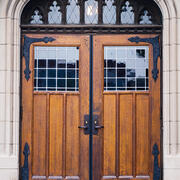
While visiting an exhibit at a gallery on Martha’s Vineyard years ago, Preston and Connie Williams found themselves taken by the vibrant colors and stunning texture of the paintings. Preston leaned closer to one of the pieces—noticing a small notation where an author’s mark would normally melt into the work. He turned to the artist and asked for the meaning of the inscription.
“To the glory of God,” the artist answered. “That’s why I paint.”
That artist was Susan Shallcross Swartz, an American impressionist painter with art in galleries and personal collections around the globe. She has received international recognition for solo exhibitions in museums throughout the United States and Europe.
Like a brush stroke from a higher power, this introduction ignited a lasting friendship centered on conversations of faith, compassion, and the divine inspiration that exudes from Susan’s work—conversations that have forever altered the fabric (and face) of the Divinity School. “One day,” Connie fondly remembers, “Preston said, ‘She ought to be introduced to HDS. So many students share an interest in art and religion.’”
In 2005, Preston introduced Susan, P ’91, P ’93, and her husband, Jim Swartz, AB ’64, P ’91, P ’93, to (then) Dean William Graham, who invited Susan to join the School’s community as an artist-in-residence. The initial collaboration illustrated a clear and meaningful connection, which led to an invitation to join the Dean’s Council.
Now, more than 15 years since Susan’s first encounter with Preston and Connie, the Swartzes are two of the School’s most devoted supporters. They have given generously for student financial aid, established the Susan Shallcross Swartz Professorship of the Practice of Christian Studies (currently occupied by the Rev. Stephanie Paulsell), and, most recently, launched the renovation of the School’s main building on campus, formally known as Andover—now named Swartz Hall in honor of Susan, Jim, and their family. One of Susan’s paintings, Heaven, is displayed in Swartz Hall as a visual reminder of this divine intervention.
As Preston reflected when recounting the poignant bond made by one good question at an art gallery, it all flowed from these, “wonderful, as they say, back stories.”
Building Community: A Space for Kinship, Worship, and Scholarship
Harvard University’s only example of collegiate-Gothic architecture, Swartz Hall is the signature building on the Divinity School’s campus. Its stone walls, soaring bell tower, impressive woodwork, and grand chapel all summon the School’s long history as a training ground for religious leaders and scholars. While HDS has evolved beyond its origins as a residential seminary for Protestant ministers, this renovation represents the first major upgrade to the building since the original construction took place over a century ago.
When the lead gift from the Swartzes was first announced in 2018, Dean Hempton shared his gratitude: “The renewal will allow us to prepare 21st-century students for lives of scholarship, ministry, service, and religiously literate leadership in all fields,” he said. “It will create new spaces that enable them to learn from each other in an atmosphere of safety, authenticity, and mutual respect. It will centralize and modernize all we do to support the academic endeavor. And it will leverage technology in new ways to bring knowledge of religion to the world far beyond our little corner of Cambridge.”
When asked about the inspiration for the largest gift in the Divinity School’s history, Susan shared that she and her husband wanted to extend their support of the School’s mission with a gift that would truly transform HDS as it began its third century: “Jim and I have seen the impact our previous gifts have had on the lives of HDS graduates and the communities they serve.”
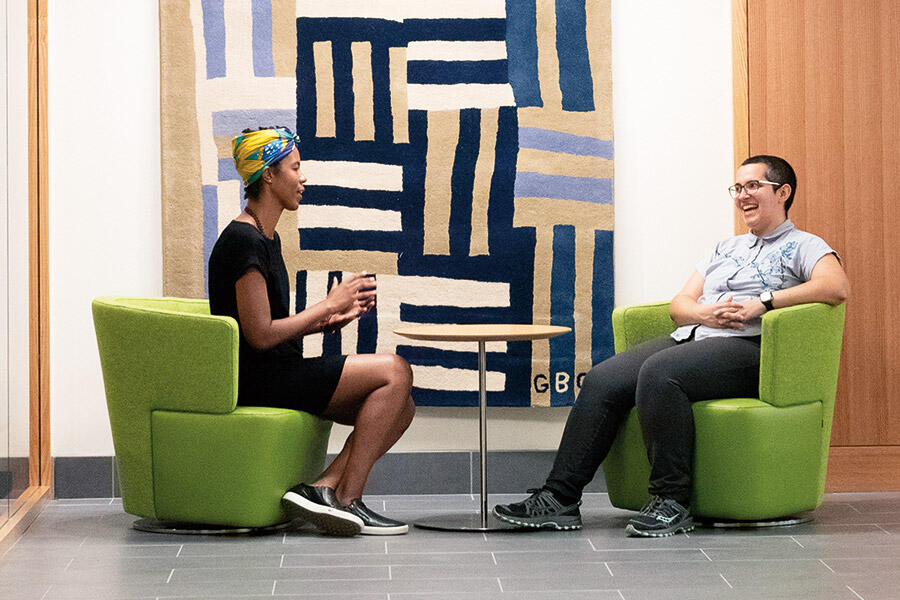
Thanking Dean Hempton and President Emerita Faust—who was leading Harvard at the time this gift was announced—Susan affirmed, “We are thrilled to be their partners in ensuring that this unique and historic building will become an innovation lab for the future of religious education and ethical leadership.”
With the groundbreaking just two years ago, that vision quickly became reality.
A Legacy of Faith and Inclusivity
One of the many gifts this renovation has inspired is the renaming of Andover Chapel, now known as the Preston N. Williams Chapel (or Williams Chapel for short). Befitting Preston’s devotion to faith and inclusivity, the chapel has been a center of spiritual life at HDS for over a hundred years. Established in the Christian religion, it has served many traditions and purposes in more recent times. The annual Billings Preaching Competition Final and the ecumenical Noon Service—a weekly gathering hosted by different student groups to pray, meditate, and engage in rituals across the School’s many faith and spiritual practices—are but two of the many events that traditionally take place in the chapel’s sacred spaces.

After an early look at the renovated chapel, Connie Williams shared her appreciation for what this space symbolizes.
“I am comforted to know that generations of HDS students will worship and celebrate meaningful rites of passage in the Preston N. Williams Chapel. This interfaith chapel signifies HDS’s respect for—and commitment to—all faiths.”
“During my half-century in this community,” she continues. “I am fortunate to have observed this growth and change. Swartz Hall affirms that we are citizens of the world and will welcome the diverse and gifted students who come to HDS.”
A Place for Pluralism
One of the new areas this renovation inspired was the multifaith space—an expansive room, with lofted ceilings and stunningly beautiful lighting, created to complement the chapel. One of the crown jewels of the project, the new multifaith space reflects one of the primary goals of the renewal project: to create a building that serves all members of the community. The movable seating, prayer rugs, and meditation cushions allow for those using the space for a multitude of rituals to feel welcome. There is also a new, adjacent ablution room for practicing Muslims to use before daily prayers.
With over 30 different traditions (including those unaffiliated with any particular belief) represented at the School, the design of this new space aligns with HDS’s mission to not only educate leaders who come from all religious and spiritual backgrounds, but also ensure they have space to pray, reflect, and engage while at HDS.
Enhanced Classrooms for Intellectual Exchange
As the physical representation of the Divinity School’s three pillars—ministry, scholarship, and public life—the building also includes both new and vastly improved classrooms and convening spaces, particularly in the glass addition that seamlessly connects the original building with the HDS Library.
With gratitude to Dean’s Council member Ralph James, MBA ’82, HDSEE ’18, HDSEE ’19, Cathy James Paglia, and the Robert and Ardis James Family Foundation for their lead gift, the building now includes a new, state-of-the-art space for teaching, learning, and gathering.
Championing the idea of “One Harvard,” Ralph contributes support and guidance to several Schools across the University, including the Harvard Graduate School of Education and the Harvard Radcliffe Institute. At HDS, he has also generously donated to the new Religion and Public Life program in support of the innovative curriculum and cross-disciplinary approach to scholarship.
“Harvard is bigger than the sum of its parts. Its impact on the world is greatest when all the parts work together,” he observes. “And there are many ways we can enhance the leadership of the Divinity School to inform and improve much—if not all—of the good work happening across the University.”
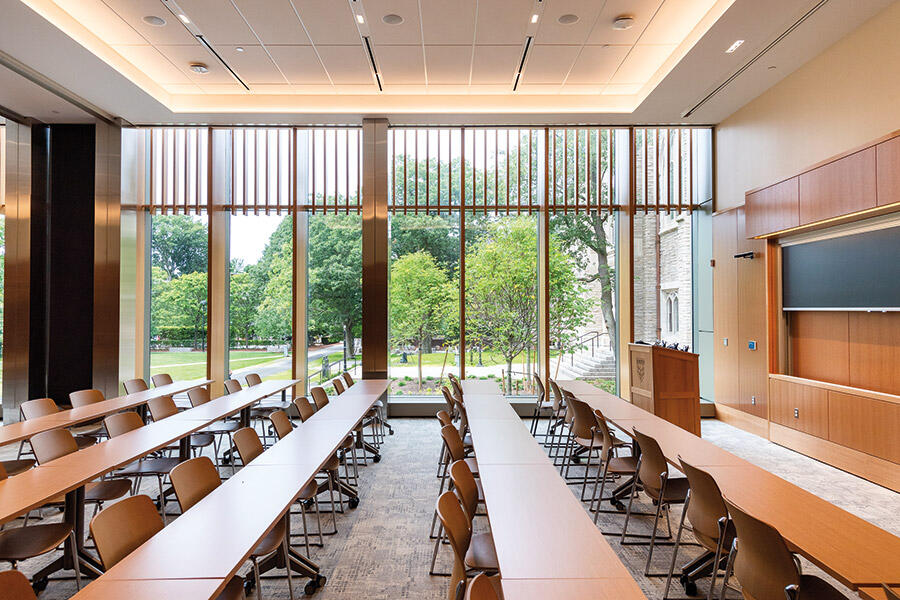
Ralph’s affinity for innovation can be seen in the new James Room. Enhanced equipment (such as projectors, cameras, and microphones) was installed to facilitate communication and intellectual exchange here in Cambridge and virtually around the globe. With a flexible design that can accommodate in-person audiences of up to 200 people, or smaller gatherings split into separate sections (James East and James West), this magnificent space greatly expands the School’s convening power for vital conversations about the role religious traditions play in the world.
The renovation of Swartz Hall embodies the School’s vision for a campus that is truly inclusive—a place where students from every imaginable tradition and background can come together in pursuit of humanity’s most fundamental questions and answers—both in classrooms worthy of their brilliance and in communal spaces that nurture the informal interactions from which new ideas and new relationships so often flow.
The Power of Collective Giving
One of the ways HDS makes a world of difference is by being a model of a multireligious community that brings together people from many different traditions in an atmosphere of authenticity and mutual respect. The Williams Chapel and new multifaith space are physical representations of the School’s commitment to pluralism. And while the modernization of Swartz Hall brought the School technologies that have become part of the fabric of our pedagogy as online teaching and learning has become more necessary, the building also includes thoughtful spaces where students can enjoy the irreplaceable experience of living and working side by side. One only need to walk by the fireplace lounge or the Commons Café to witness the warmth of long-awaited face-to-face connections.
Building on the generosity of both the Swartz and James families, this renovation came to life with collective generosity. Artfully placed throughout the vibrant new center of the HDS campus, we see tributes to community and connection. The new Garvin Room was named with an anonymous gift in memory of a beloved HBS faculty member and friend of the School—David Garvin. Chris and Anne Flowers also generously contributed an unrestricted gift, recognized with a plaque honoring a family member who was a minister ordained the same year HDS celebrated its opening in 1816.
Supporters of the HDS Fund also helped make this moment possible. With more than a thousand gifts ranging from $5 to $50,000, the HDS Fund fortifies the School in a number of important ways—including bolstering financial aid for students and providing instrumental funds for infrastructure needs. A plaque recognizing the many supporters who gave $250 or more in fiscal year 2021 will be displayed to celebrate the power of collective giving.
Dean Hempton often reflects that Harvard Divinity School is only as great as the people who learn, teach, and work together in support of the School’s vision. Building on a strong foundation, the new Swartz Hall offers the HDS community a renewed space for kinship, worship, and scholarship in service of a just world at peace across religious and cultural divides.
Honoring the Past
A goal of renewing our century-old main campus building was preserving the historical significance and character-defining details, while increasing energy efficiency and creating a welcoming, accessible, and modern environment.
What you should know about the restoration of Swartz Hall:
- Samples of the 100-year-old slate roof and original wood doors were used to craft new versions in the closest matching material and style from when the building was first constructed. Once identified, the slate was brought in from a quarry in Vermont.
- The exterior doors (as well as the doors to both the Braun Room and the Williams Chapel) were restored in Newburyport, MA, by a woodworking company—certified by the state as a Minority/Woman-Owned Business Enterprise—that uses leftover scraps and sawdust to fuel its clean-burning biomass furnace.
- The replacement of the building’s stained-glass windows used the same traditional techniques that created the original windows 100 years ago. The medallions in the center of some of the windows in the Braun Room and staircases are comprised of nearly 80 pieces of glass.
- Tucked inside of each Swartz Hall window is a vapor barrier, which helps protect the wooden frame, allowing it to last longer. The insulation helps keep the building airtight and minimizes the loss of heat in the winter and cool air in the summer, reducing energy consumption.
- In order to create new entryways between the addition and the existing Swartz Hall structure, pieces of granite stone had to be removed. Instead of disposing of these stones, they were repurposed to create the new Commons fireplace.
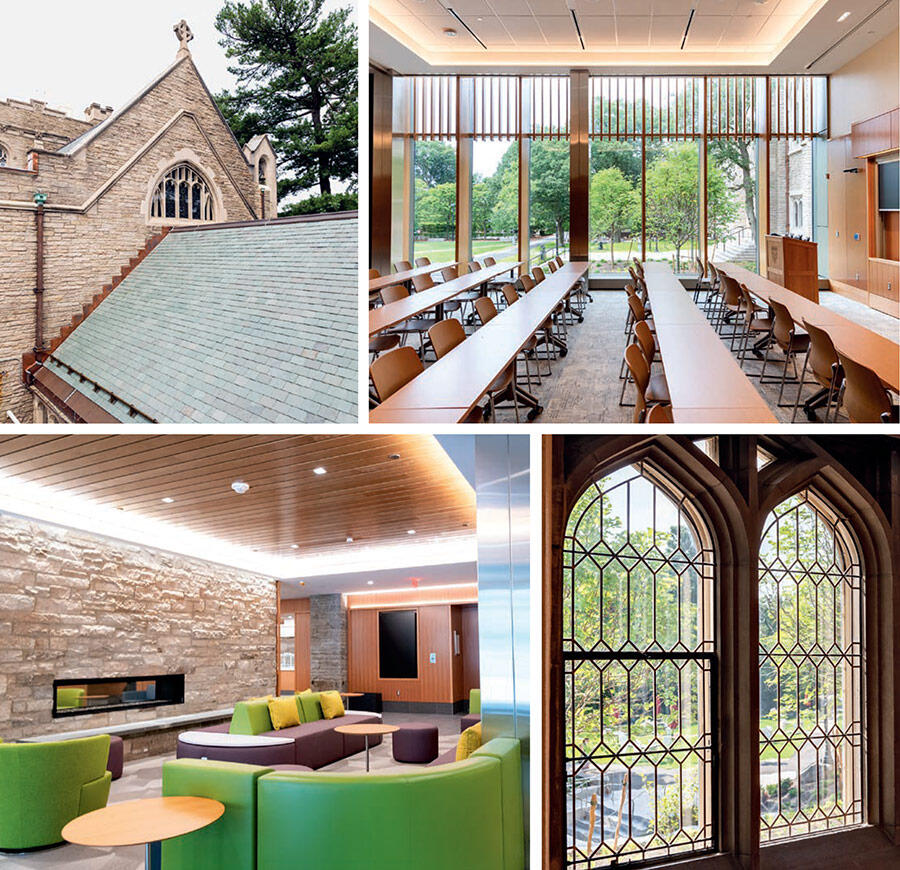
Embracing the Future
What you should know about the reinvention of Swartz Hall:
- The James Room, a 200-seat auditorium and classroom space, will encourage connections, transform emerging teaching and learning possibilities, and welcome global conversations in real time through improved technology.
- A new wireless network has been installed for the entire campus, providing better coverage both inside and outside the buildings. New points of coverage were also installed to allow for better Internet access on the campus green.
- Throughout the building, new ramps, elevators, accessible entryways, gathering spaces, and restrooms make the building more accessible to all.
- The sustainability measures included in the building renovation will help advance the University’s effort to combat climate change and to make Harvard a fossil-fuel-free campus by 2050.
- The glass addition that connects the original structure with the HDS Library also creates a window to the landscape outside—bringing the beauty of nature inside the new building.
Celebrating Preston and Connie Williams
With the opening of Swartz Hall, the Divinity School honored Preston N. Williams, PhD ’67, Houghton Professor of Theology and Contemporary Change Emeritus, and Dr. Constance W. Williams. In recognition of their exceptional service and leadership across HDS (and broader Harvard communities), Andover Chapel has been renamed the Preston N. Williams Chapel. Additionally, the Constance W. and Preston N. Williams Scholarship Fund has been established to support future leaders at the School.
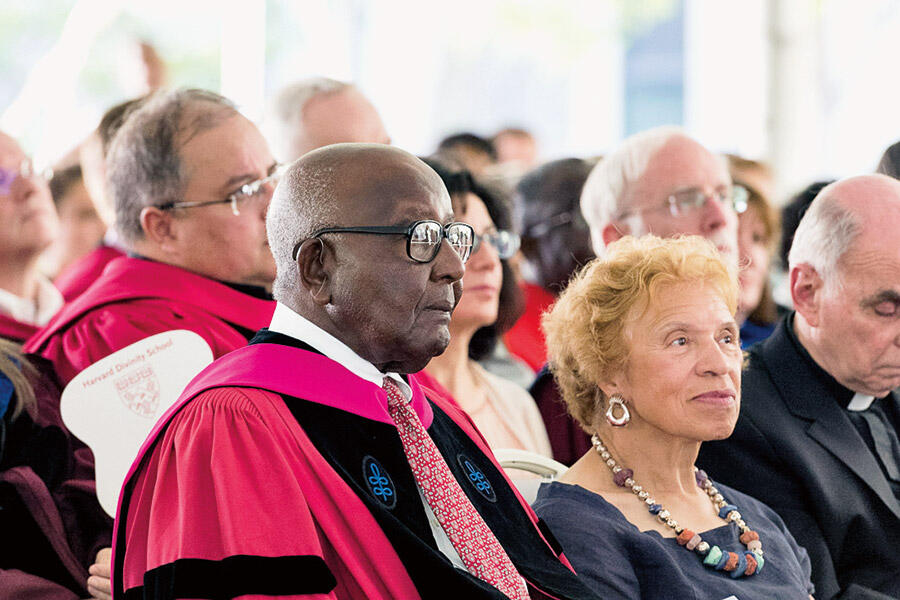
Preston, a renowned scholar who has taught at the Divinity School since 1971, has spent his entire ministry on college and university campuses. He was the first tenured African American faculty member of HDS and the first to lead the School as acting dean, from 1974 to 1975. Preston still teaches a course on the ethical and religious thought of Martin Luther King, Jr., and the Harvard Alumni Association recently recognized Preston’s service to the University with a 2021 Harvard Medal.
Connie, Associate Professor Emerita of The Heller School for Social Policy and Management at Brandeis University, has an extensive background in direct practice, public service, and education. From 1972 to 1983, she was the founding director of the undergraduate social work program at Boston University’s Metropolitan College. She also served as the chief policy analyst in the MA Governor’s Office of Human Resources. A professor, policy expert, and author, Connie has dedicated her life to improving social conditions for all.
Preston and Connie have been steadfast advocates for equality throughout their many leadership roles in higher education and their devotion to the Harvard community for over 50 years. To honor their legacy of fostering opportunity for students of all races, genders, and backgrounds, the Constance W. and Preston N. Williams Scholarship Fund will support HDS students actively working toward belonging and inclusion, including anti-racism work, through their studies and experiences.
—by Caroline Cataldo and Amie Montemurro